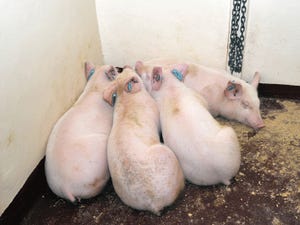Northern perspective on USMCA
Only Canadian ratification stands between new NAFTA from becoming reality.

They may call it by a different name, but Canadian pork producers are just as pleased as their U.S. counterparts with the new trade deal between the United States, Canada and Mexico.
According to Andrew Dickson, general manager of Manitoba Pork, the Canada-United States-Mexico Agreement (or CUSMA) is a good pact to replace the North American Free Trade Agreement that had been in place since 1994, to continue trade between the three countries.
"We were happy with NAFTA, so the key thing was not to change the good deal we had with NAFTA, on both sides because there was essentially zero tariffs and zero barriers to move our pork and live animals through the borders," he says. "The new trade agreement does that."
Dickson wants to point out that American hog producers may not realize that the economics of the Canadian pig market are essentially based on the USDA daily National Base Price. "All our formulas are on your USDA national price that's announced. When your price goes up, our prices go up, your price goes down, our price goes down. It's automatic. There's no unique Canadian price," he says. "So we are hoping that with more normal trading patterns coming into play we'll be able to return to exporting more product out of North America, create more tension in the marketplace between processors and producers and prices will rise, and that will have a huge effect on us. Canada is a very large country but has a very small population. The domestic market is relatively small for us."
With that in mind, Canada relies heavily on exports, exporting 70% of its pork production, as where 30% of U.S. pork production is exported. Competition for the global market drives what each country ships in exports, but Dickson says Canadian producers also battle currency exchange rates.
"If you want to expand, you're going to think about how you're pricing your product overseas and so on. As your exports increase, any changes in your exchange rate with other countries will affect the price you get," he says. "Our farmers are reliant on this USDA price. Any changes in currency have a major effect for us. As the Canadian dollar goes up in value against the American dollar, our producers actually get less money. You know, the U.S. producer says, well, the price never changed, but actually for us they did."
On the flip side of this equation, Dickson admits that when the value of the Canadian dollar goes up, producers there are then able to buy more U.S. corn and soybeans "because it gets cheaper in a sense. … But the margin is the key thing for us. The margin goes down when the Canadian dollar goes up in value."
Selling weanlings to the United States is big business for Canadian producers, sending 5 million baby pigs south, with just under 3 million of those coming from central Manitoba. Two-thirds of those pigs end on Iowa farms and the remaining one-third end up in either Minnesota or South Dakota.
Of course, this trade deal covers more than weanling pigs and agriculture products, and it is a well-paved two-way street. According to the Government of Canada Agriculture and Agri-Food Canada, total U.S.-Canada agriculture and agri-food trade totals $49.7 billion — $25.7 billion in U.S. ag products going to Canada and $24 billion in Canadian products coming to the United States. Pork and beef products make up $2.3 billion of the product coming from Canada.
Dickson feels the new deal also has "a commitment to try and reduce regulatory burdens between the three countries as well, which is good. And more harmonization of the food inspection systems. There are mechanisms now to try and help resolve those things."
Bringing certainty is a big thing that Dickson sees in CUSMA or USMCA.
"These are long-term agreements between countries that have traded for centuries, and so anything to bring more stability and understanding of how trade can work will encourage investment. Because for example, when one builds a barn, it's a 30-year investment, so you kind of want to know how's this all going to work out. You don't want to be hearing well, our current marketplace, all the rules regarding it in terms of trade and so on, they're all up for grabs every five years. Then you go, 'Oh, maybe I don't do that (build the new barn).' These are long-term standing arrangements."
Even though he sees this as a long-standing trade pact between the three countries, there are clauses in place to allow for amendments as needs arise, without having to renegotiate the entire deal. Under NAFTA there were also dispute mechanisms, but Dickson says his country "viewed that as not being very workable. The new agreement clarifies some of the rules of how those dispute mechanisms are going to work."
Once the new deal is implemented Dickson does not envision a static document. "This is the negotiation between human beings. You can change these things. The key one on all of these is this, the intent and willingness to carry out the basic thrust to do business with each other in a rational way to the benefit of both sides," he says. "This is not win-lose, right? It's a win-win situation."
He admits that the true workings of the new deal will remain to be seen once it is actually enforced.
And just when might that be?
Mexico and the United States have both approved the agreement, and the Canadian Parliament has now taken it up since returning from Christmas break. Dickson says it should be a simple matter of working through the process, a process that could take until the end of February or early March.
CUSMA or USMCA will go into effect 90 days after Canada ratifies the agreement.
About the Author(s)
You May Also Like



